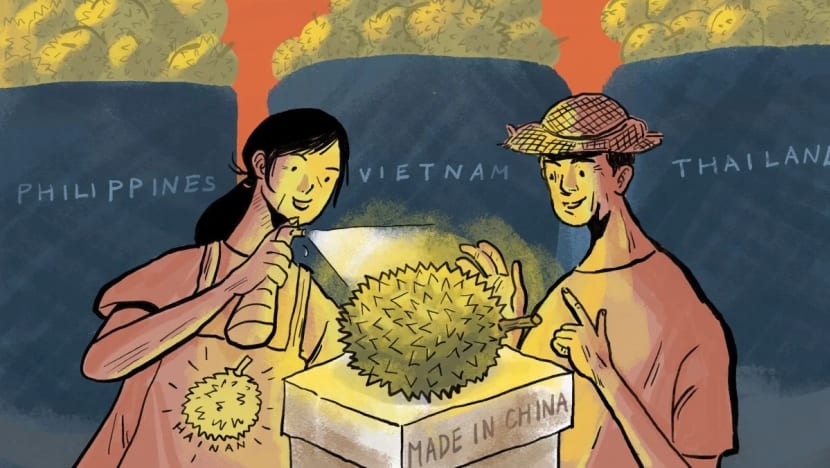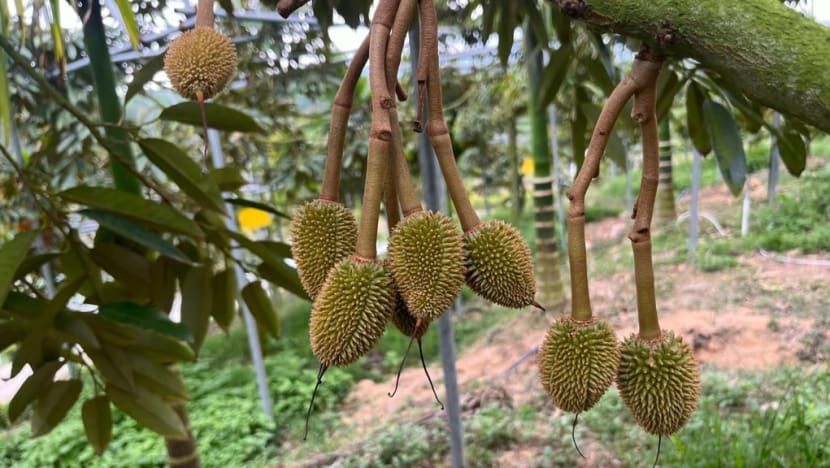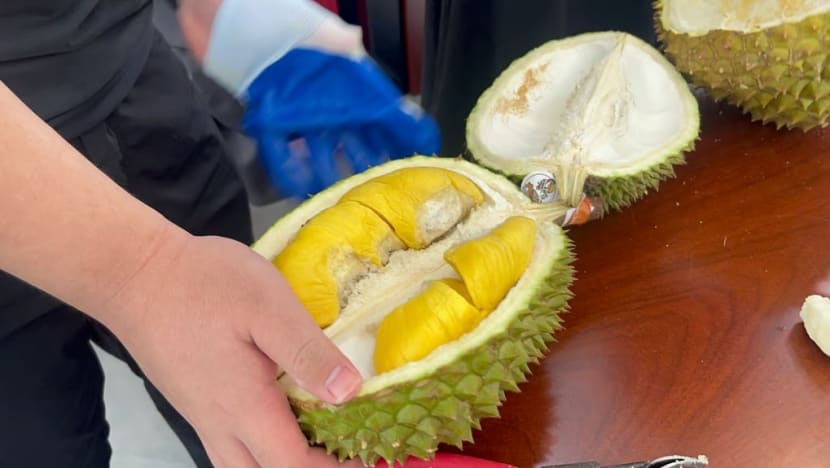1 man, 10,000 trees: Why China’s fledgling durian farms still can’t compete with Southeast Asian imports
The arrival of home-grown durians on Chinese shelves in the past two years has sparked a gold rush for tropical agriculture in the world’s largest durian market, but it has a long way to go before it can compete with imports from Southeast Asia.

In 2024, China imported 1.56 million tonnes of durians worth nearly US$7 billion, mainly from Southeast Asian countries. (Illustration: SCMP/Brain Wang)

This audio is generated by an AI tool.
HAINAN: From dawn to midnight, Huang Qijun nurtures and tends to 10,056 durian trees, every day.
By late March, the mild weather in China’s southernmost province of Hainan – with occasional overcast skies and light showers – ushered in the flowering season for durian trees. And Huang got to work.
On this nearly 40-hectare durian orchard that is mostly managed by only one caretaker, much of the work is handled by machines: Each tree is equipped with sensors that monitor temperature and humidity.
So, when one needs water, Huang receives an alert on his smartphone. With a simple tap of the app, towering irrigation sprinklers beside the tree activate instantly.
Yet, not all tasks can be delegated to smart systems. Weeding, for instance, remains a hands-on job.
Most durian trees grow on steep slopes – impossible terrain for robots to work – so Huang must clear the relentless weeds manually, day after day.
And at night, when the fragrant white blossoms open, pollination – another task to be done manually – begins.
On some trees that were ahead of schedule, clusters of young fruits have already reached the size of cherries.
As they grow bigger, Huang will inspect them one by one, selecting only the best to keep.
Then he will carefully tie the chosen ones with thin twine to branches so when summer arrives and the durians ripen, they will not abruptly fall to the ground.
“Managing these trees from saplings to fruiting is like raising a child – every step requires meticulous care,” Huang said, standing beside a slightly crooked tree.
“This one was damaged in last year’s typhoon. It could have borne 15 or 16 fruits, but this year, I’ll let it keep only five or six.”
Standing at ground zero for China’s home-grown durian, trees in Huang’s plantation are less than five years old – much younger than those in the decades- or centuries-old farms prevalent in Southeast Asian countries, home to the spiky tropical “king of fruits”.
The older the tree, the more fruit it can bear, and the sweeter and creamier the fruit tastes.
But the arrival of scarce home-grown durians on Chinese shelves in the past two years has already sparked a gold rush for tropical agriculture in the world’s largest durian market, with investors pouring capital into fledgling durian farms from terraced hillsides on Hainan Island to the subtropical lowlands of China’s southern border provinces such as Yunnan and Guangxi.
As these tender plants mark China’s leap from a pure importer to a grower, their significance has created ripples in the global trade of the fruit, and potentially beyond.

In recent years, Beijing’s opening up of its market to more countries for fresh durians has been dubbed “durian diplomacy”, spurred by both the growing appetite of Chinese durian lovers and Beijing’s wish to cement its ties with Southeast Asia.
But Du Baizhong, general manager of the Hainan Youqi Agricultural Company, said that the notion of domestic durians replacing imports would be wishful thinking.
The company is the first and biggest durian grower in China, with more than 200,000 durian trees in Hainan – including those managed by Huang.
“Southeast Asia probably doesn’t need to care about China’s small-scale cultivation because we are not a real competitor,” Du said.
“Even if the entirety of Hainan Island were planted with durians, it still couldn’t meet the massive domestic demand in our country.”
China’s fresh durian imports have hit record highs in volume for four consecutive years. In 2024, imports totalled 1.56 million tonnes, worth nearly US$7 billion, according to data from China Customs.
For years, Thailand dominated China’s booming demand for fresh durian as the sole approved exporter – until 2022, when Vietnam broke the monopoly.
The market further expanded with the Philippines gaining access in 2023 and Malaysia in 2024.
Domestically produced durians simply cannot compete with Southeast Asia in terms of yield and price, given the scarce growing experience, more volatile climate and higher labour costs, Du said.
Last year, the price of home-grown “golden pillow” durians easily doubled that of those imported from Thailand.
“For Chinese durians, there’s only one path forward: we must focus on producing high-quality products,” Du said.
“Hainan can learn from Japan. Japan has a relatively small land area, so they prioritise quality above all else in agricultural development.”
Due explained that the key to premium quality for durians is tree-ripening, meaning the fruits are left to fully mature on the branch until they drop naturally (and are snagged by the twine).
Made-in-Hainan means ripened durians do not need to go through customs clearance and can freshly arrive at customers around the country within 48 hours by air – the peak flavour lasts only 3-4 days after harvest, with quality noticeably declining every day after that, Du said.
In comparison, most imported durians – primarily from Thailand – are picked at 60 to 70 per cent maturity and then artificially ripened with chemicals, he said.
While this extends their shelf life, it sacrifices quality by triggering uneven texture and enhancing the fruit’s infamous smell that deters many – it is not true durian aroma, but ethylene by-products, he explained.
While people in China consume more than 85 per cent of global durians annually, there was a long-held belief in Hainan that the country’s only tropical province was still not suitable for the growing durians, despite the region’s similar latitude to Southeast Asia.
Previous large-scale cultivation efforts all failed, though some individual trees planted in household backyards did bear fruit.
Durian growers in China focus on quality to meet huge domestic demand for pungent fruit
The crux lies in monsoons deeply influencing the island’s weather, making it more volatile in terms of temperature and precipitation – shifting between sunshine and storms. That is not ideal for durian trees, which need a more stable climate.

Youqi’s first attempt at large-scale durian farming on this land was in 2019.
Yet, the first phase saw 6,000 seedlings die, with a survival rate of just 60 per cent, resulting in an economic loss of 70 million yuan (US$9.6 million).
The company later adopted an approach to grow different heights of companion plants: banana trees with large leaves shield durian seedlings from the harsh midday sun, while taller Areca palms act as windbreakers.
Meanwhile, low-lying pineapple plants further help reduce ground temperature.
The tactical measures boosted the seedling survival rate to over 95 per cent.
In 2023, Youqi’s young durian trees – then three years old – yielded for the first time, producing around 50 tonnes of the fruit. A year later, the output reached 260 tonnes.
This year, Du has estimated that the total harvest will reach 500 to 600 tonnes, and the last thing he was worried about was where to sell them.
“These durians will be completely pre-sold by the time they grow to ping-pong-ball size – the earliest stage when more accurate yield estimates become possible,” Du said.
Currently, Du’s highest durian trees are around 7m tall, compared with mature Southeast Asian plantations where trees reach as high as 30m. A significant surge in output is likely to happen within the next two years, when each tree will become capable of yielding more than 50 durians, Du said.
“Our trees are still like kids in kindergarten compared with those in Southeast Asia,” Du said. “After a decade, each tree should be able to bear more than 100 fruits per harvest.”
In China, as concerns over economic growth mount, few industries now give insiders the same promising feeling as that of durian farming.
Naturally, large amounts of cash have been flowing to the sector in recent years, from coal mine owners in Shanxi to manufacturing bosses in Guangdong.
Micheal Wang, or better known as Maikou Wang among his followers, hosted more than 800 batches of bosses looking to invest in durian plantations last year.
Running social media accounts on different Chinese platforms, teaching knowledge about durian farming, Wang also acts as a broker for saplings and lands.
“Durian is the most countercyclical fruit of all,” Wang said. “Because of the pandemic and others, with all the consumption downgrading, businesses struggled, and fruits were hard to sell. But the import volume of durian kept rising.”
The planting area for durian in China has at least doubled annually in the past few years, Wang said.
Currently, a golden rule for selecting growing areas for durians in China is a narrow swathe located between 18 degrees north latitude and 19 degrees north latitude – which points only to a small part of southern Hainan.
And while efforts are under way to develop cold-resistant varieties of durian, this may take years, perhaps even a decade.
Nonetheless, some of the more bold industry investors are already looking farther north, setting their sights on the mainland, with a new darling area being Xishuangbanna.
It is a small and tropical region in the southwestern province of Yunnan, near the border with Myanmar and Laos, though it is still unclear whether the area can be industrialised as successfully as Hainan.
“There’s a palpable sense that Xishuangbanna’s durian-farming scene today mirrors Hainan’s in 2020 – teetering on the brink of explosive growth,” Wang said.
This article was first published on SCMP.

















